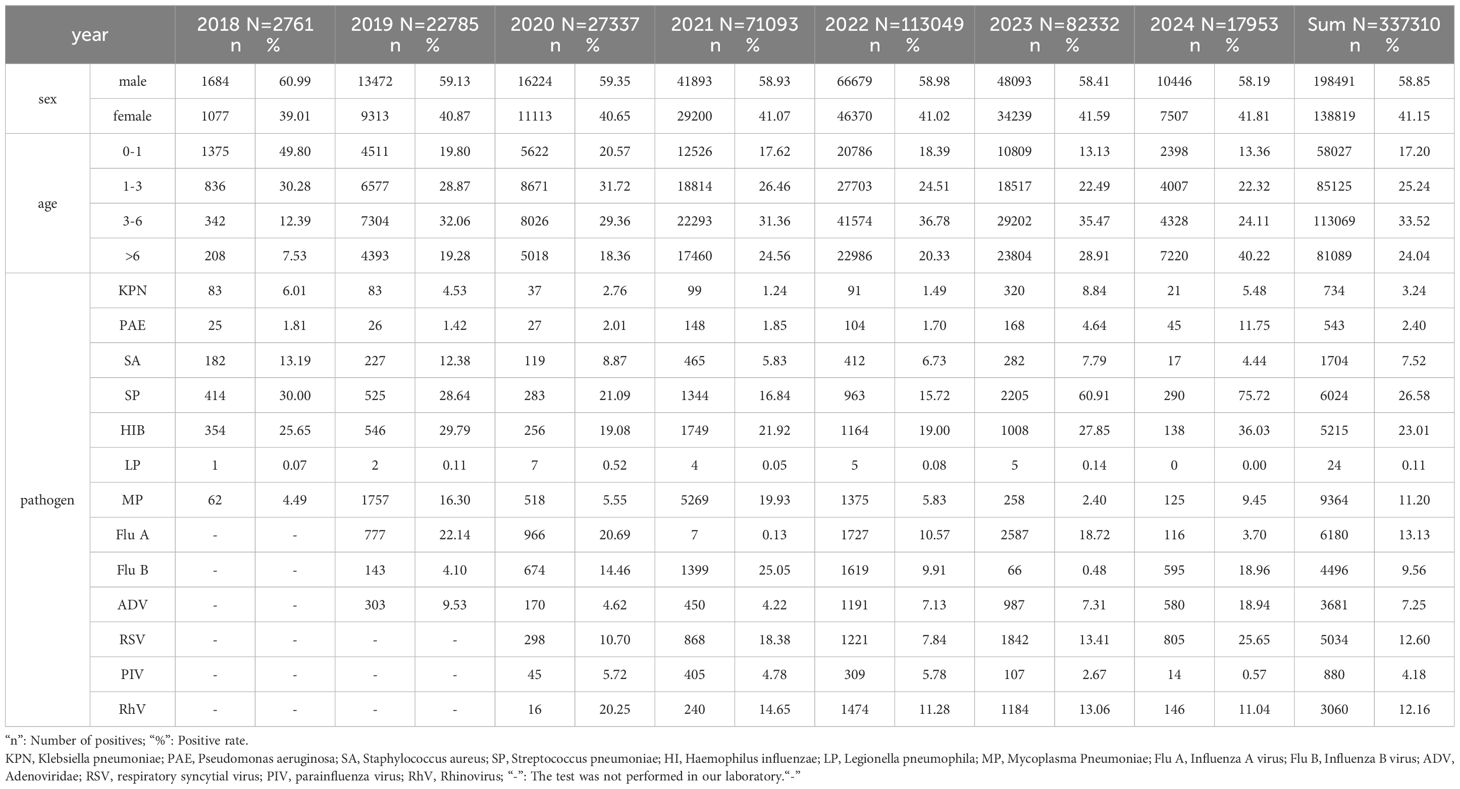- 1Clinical Laboratory, Children’s Hospital Affiliated to Shandong University, Jinan, China
- 2Clinical Laboratory, Jinan Children’s Hospital, Jinan, China
A Correction on
Changes in children respiratory infections pre and post COVID-19 pandemic
By Yue Y, Wu D, Zeng Q, Li Y, Yang C, Lv X and Wang L (2025). Front. Cell. Infect. Microbiol. 15:1549497. doi: 10.3389/fcimb.2025.1549497
In the published article, there was an error in Table 1 as published. The end date was not “January 31, 2014”, it should be corrected to “January 31, 2024”; and in Table 1, Under the “Age” column, the category “01” lacks a hyphen. This should be revised to “0-1” for consistency with standard notation. The corrected Table 1 and its caption appear below.
In the published article, there was an error in the Funding statement. This research was funded by one Science and Technology Development Program of Jinan Municipal Health Commission, not two. The original text: “The author(s) declare that financial support was received for the research and/or publication of this article. This research was funded by two Science and Technology Development Program of Jinan Municipal Health Commission (No. 2023-1–60 and No. 2023-2-139). All grant numbers and funding information are included in full and accurately.” The correct Funding statement appears below.
“The author(s) declare that financial support was received for the research and/or publication of this article. This research was funded by Science and Technology Development Program of Jinan Municipal Health Commission (No. 2023-1-60). All grant numbers and funding information are included in full and accurately.”
In the published article, there was an error. The bacterial name “Listeria monocytogenes (abbreviated as LP)” is incorrect. It should be revised to “Legionella pneumophila (LP).”
A correction has been made to Abstract, Results:, From line 81 to line 86. This sentence previously stated:
“A variety of ARIs pathogens, including Influenza A (Flu A), Influenza B (Flu B), Adenovirus (ADV), Rhinovirus (RhV), and Respiratory Syncytial Virus (RSV), as well as co-infecting bacterial such as Klebsiella pneumoniae (KPN), Pseudomonas aeruginosa (PAE), Streptococcus pneumoniae (SP), Haemophilus influenzae (HI), and Listeria monocytogenes (LP), reached a peak positive rate at the age of 3.”
The corrected sentence appears below:
“A variety of ARIs pathogens, including Influenza A (Flu A), Influenza B (Flu B), Adenovirus (ADV), Rhinovirus (RhV), and Respiratory Syncytial Virus (RSV), as well as co-infecting bacterial such as Klebsiella pneumoniae (KPN), Pseudomonas aeruginosa (PAE), Streptococcus pneumoniae (SP), Haemophilus influenzae (HI), and Legionella pneumophila (LP), reached a peak positive rate at the age of 3.”
The authors apologize for this error and state that this does not change the scientific conclusions of the article in any way. The original article has been updated.
Publisher’s note
All claims expressed in this article are solely those of the authors and do not necessarily represent those of their affiliated organizations, or those of the publisher, the editors and the reviewers. Any product that may be evaluated in this article, or claim that may be made by its manufacturer, is not guaranteed or endorsed by the publisher.
Keywords: COVID-19, respiratory infection, non-pharmaceutical interventions, children, qPCR
Citation: Yue Y, Wu D, Zeng Q, Li Y, Yang C, Lv X and Wang L (2025) Correction: Changes in children respiratory infections pre and post COVID-19 pandemic. Front. Cell. Infect. Microbiol. 15:1644555. doi: 10.3389/fcimb.2025.1644555
Received: 10 June 2025; Accepted: 11 June 2025;
Published: 27 June 2025.
Approved by:
Frontiers Editorial Office, Frontiers Media SA, SwitzerlandCopyright © 2025 Yue, Wu, Zeng, Li, Yang, Lv and Wang. This is an open-access article distributed under the terms of the Creative Commons Attribution License (CC BY). The use, distribution or reproduction in other forums is permitted, provided the original author(s) and the copyright owner(s) are credited and that the original publication in this journal is cited, in accordance with accepted academic practice. No use, distribution or reproduction is permitted which does not comply with these terms.
*Correspondence: Xin Lv, ZXR5eWp5a2x2eGluQDE2My5jb20=; Ling Wang, V2xpbmdldHl5QDE2My5jb20=
†These authors have contributed equally to this work and share first authorship
 Yuanyuan Yue1,2†
Yuanyuan Yue1,2† Qian Zeng
Qian Zeng Xin Lv
Xin Lv